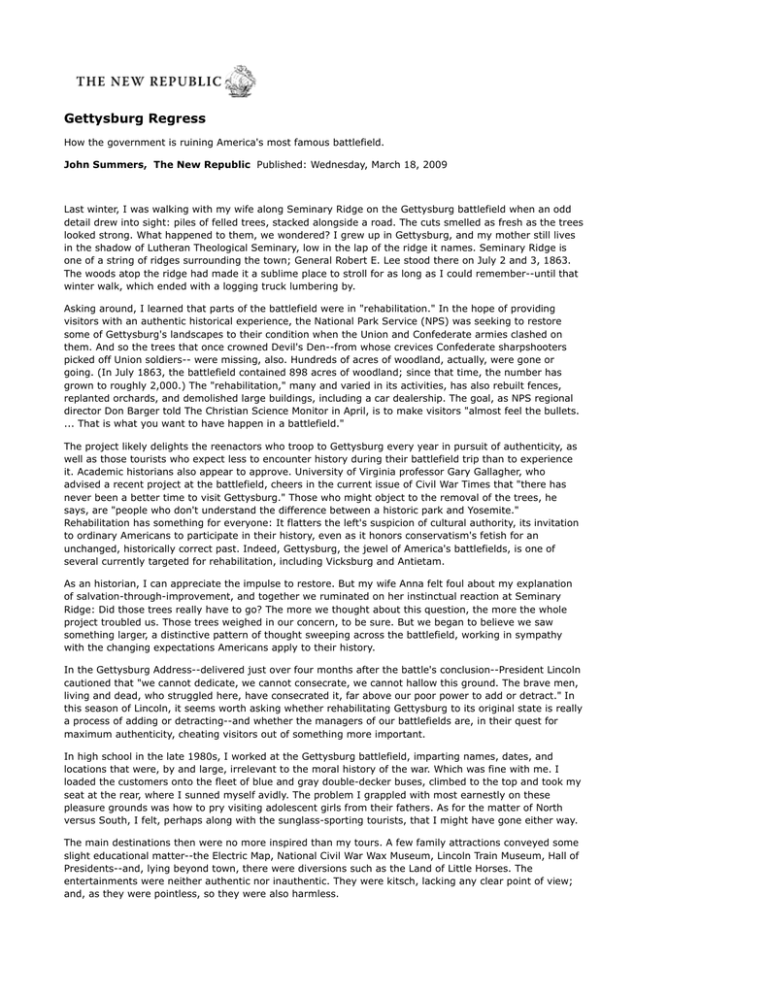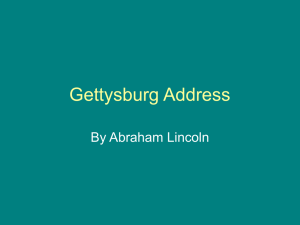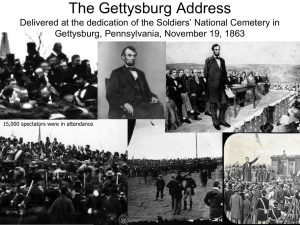
Gettysburg Regress
How the government is ruining America's most famous battlefield.
John Summers, The New Republic Published: Wednesday, March 18, 2009
Last winter, I was walking with my wife along Seminary Ridge on the Gettysburg battlefield when an odd
detail drew into sight: piles of felled trees, stacked alongside a road. The cuts smelled as fresh as the trees
looked strong. What happened to them, we wondered? I grew up in Gettysburg, and my mother still lives
in the shadow of Lutheran Theological Seminary, low in the lap of the ridge it names. Seminary Ridge is
one of a string of ridges surrounding the town; General Robert E. Lee stood there on July 2 and 3, 1863.
The woods atop the ridge had made it a sublime place to stroll for as long as I could remember--until that
winter walk, which ended with a logging truck lumbering by.
Asking around, I learned that parts of the battlefield were in "rehabilitation." In the hope of providing
visitors with an authentic historical experience, the National Park Service (NPS) was seeking to restore
some of Gettysburg's landscapes to their condition when the Union and Confederate armies clashed on
them. And so the trees that once crowned Devil's Den--from whose crevices Confederate sharpshooters
picked off Union soldiers-- were missing, also. Hundreds of acres of woodland, actually, were gone or
going. (In July 1863, the battlefield contained 898 acres of woodland; since that time, the number has
grown to roughly 2,000.) The "rehabilitation," many and varied in its activities, has also rebuilt fences,
replanted orchards, and demolished large buildings, including a car dealership. The goal, as NPS regional
director Don Barger told The Christian Science Monitor in April, is to make visitors "almost feel the bullets.
... That is what you want to have happen in a battlefield."
The project likely delights the reenactors who troop to Gettysburg every year in pursuit of authenticity, as
well as those tourists who expect less to encounter history during their battlefield trip than to experience
it. Academic historians also appear to approve. University of Virginia professor Gary Gallagher, who
advised a recent project at the battlefield, cheers in the current issue of Civil War Times that "there has
never been a better time to visit Gettysburg." Those who might object to the removal of the trees, he
says, are "people who don't understand the difference between a historic park and Yosemite."
Rehabilitation has something for everyone: It flatters the left's suspicion of cultural authority, its invitation
to ordinary Americans to participate in their history, even as it honors conservatism's fetish for an
unchanged, historically correct past. Indeed, Gettysburg, the jewel of America's battlefields, is one of
several currently targeted for rehabilitation, including Vicksburg and Antietam.
As an historian, I can appreciate the impulse to restore. But my wife Anna felt foul about my explanation
of salvation-through-improvement, and together we ruminated on her instinctual reaction at Seminary
Ridge: Did those trees really have to go? The more we thought about this question, the more the whole
project troubled us. Those trees weighed in our concern, to be sure. But we began to believe we saw
something larger, a distinctive pattern of thought sweeping across the battlefield, working in sympathy
with the changing expectations Americans apply to their history.
In the Gettysburg Address--delivered just over four months after the battle's conclusion--President Lincoln
cautioned that "we cannot dedicate, we cannot consecrate, we cannot hallow this ground. The brave men,
living and dead, who struggled here, have consecrated it, far above our poor power to add or detract." In
this season of Lincoln, it seems worth asking whether rehabilitating Gettysburg to its original state is really
a process of adding or detracting--and whether the managers of our battlefields are, in their quest for
maximum authenticity, cheating visitors out of something more important.
In high school in the late 1980s, I worked at the Gettysburg battlefield, imparting names, dates, and
locations that were, by and large, irrelevant to the moral history of the war. Which was fine with me. I
loaded the customers onto the fleet of blue and gray double-decker buses, climbed to the top and took my
seat at the rear, where I sunned myself avidly. The problem I grappled with most earnestly on these
pleasure grounds was how to pry visiting adolescent girls from their fathers. As for the matter of North
versus South, I felt, perhaps along with the sunglass-sporting tourists, that I might have gone either way.
The main destinations then were no more inspired than my tours. A few family attractions conveyed some
slight educational matter--the Electric Map, National Civil War Wax Museum, Lincoln Train Museum, Hall of
Presidents--and, lying beyond town, there were diversions such as the Land of Little Horses. The
entertainments were neither authentic nor inauthentic. They were kitsch, lacking any clear point of view;
and, as they were pointless, so they were also harmless.
Today's drive to refurbish Gettysburg, more ambitious in every respect, has not stinted on inspiration--or
controversy. A $135-million Museum and Visitor Center, which opened last spring, has lately grabbed
headlines thanks to allegations of ethical impropriety. (Questions are swirling about why two firms- -one
run by the head of the Gettysburg Foundation, the Park Service's partner in building the new center; the
other run by his son--were selected to do work at the battlefield.) Less attention, however, has been
trained on the ongoing effort to rehabilitate parts of the battlefield to their July 1863 states. This effort
marks the latest chapter in a contest between dueling conceptions of Gettysburg--the battlefield as
unchanging relic and the battlefield as living memorial.
In April 1864, the Pennsylvania legislature chartered the Gettysburg Battlefield Memorial Association
(GBMA). It had taken burial gangs until March of that year to complete the bulk of their work and inter
most of the Union dead in Soldiers' National Cemetery. And not until 1873 were the Confederate dead
removed from mass graves and reburied in Richmond and Raleigh, Charleston and Savannah. The GBMA
made some efforts in the direction of restoration-- repositioning cannons, for example--and its founder
argued for maintaining the July 1863 appearance of some key aspects of the battlefield. At the same time,
he urged the construction of monuments, while his organization's charter called for it to commemorate the
carnage with "works of art and taste." In 1866, the legislature empowered the GBMA to plant trees at the
site. By 1895, when the Department of War assumed jurisdiction and created the Gettysburg National
Military Park, the GBMA held title to 600 acres of land from which it had carved 17 miles of roads. In its
first decade of administration, the War Department added more than 800 acres of land, planted nearly
17,000 additional trees, and improved roads. The commemorative work of boosters and government
officials utterly transformed the battlefield.
Administrative control over the land migrated from the War Department to the Department of the Interior
and the National Park Service in 1933; and developments surrounding the battlefield continued to reflect
tension between the two conceptions of Gettysburg. On the one hand, New Deal officials issued a six-year
general plan that identified a desire to return the land to its July 1863 appearance. Barns were restored,
fences and walls rebuilt. Using workers from the Civilian Conservation Corps, the Park Service pared away
overgrowth for the sake of an authentic view at Little Round Top. Yet, in other respects, the site continued
to migrate away from its 1863 appearance. In 1938, at the battle's seventy-fifth anniversary, President
Roosevelt came to dedicate the Eternal Light Peace Memorial, whose torch--situated above a granite and
limestone monument--was meant to symbolize domestic unity while Europe rearmed. Fewer than 2,000
Gettysburg veterans attended the ceremony, and their average age was over 90. Perhaps they exercised
something of a check on the drive for authenticity: One can see how wishing for an authentic battle
experience in the presence of these survivors--who did not have the experience of the battle so much as
they were had by it--might have been considered tasteless.
Eventually, however, the veterans died off, and, as told in Jim Weeks's Gettysburg: Memory, Market, and
an American Shrine and Harlan Unrau's Administrative History: Gettysburg National Military Park and
Gettysburg National Cemetery, Pennsylvania, the idea of rehabilitation continued to inform new plans for
the park. In the late 1950s, President Eisenhower--whose farm was near the battlefield--egged on the
campaign to restore Gettysburg. "I think it is a pity this one piece of terrain is not kept so that youngsters
can see it nearly like it was in 1863," the president told Parade magazine.
Rehabilitation was a major initiative in the National Park Service's 1999 General Management Plan, thanks
to John Latschar, the park's current superintendent. Last summer, Latschar explained to The Gettysburg
Magazine how he could tell, soon after arriving in 1994, that a comprehensive program was needed to
rescue the battlefield from the encroachments of time. "I'd been here a couple of weeks maybe and they
scheduled my tour and I went out with a retired Marine colonel who's one of our best guides," he said. "He
carried with him a stack of historic photographs that was probably three-quarters of an inch thick. I
thought, what's he need all these for? But what he needed them for was to explain the course of the
battle. Because so much of what the commanders could see in 1863 was obscured by vegetation that had
grown up. And it was at that moment, I can remember thinking to myself, something's got to be done
about this."
Is it possible to return vast tracts of land to their appearance in 1863? On the Park Service's website,
Latschar explains that he is drawing on maps, participant reports of the battle, diaries, and newspaper
accounts for a description of the battlefield's original condition. If that sounds straightforward, consider
how little anyone knows for certain about the site's prewar appearance. Very few photographs of the
Gettysburg outdoors from before the battle exist. William Frassanito's Early Photography at Gettysburg,
published in 1995, identified M.S. Converse's map as the lone relatively detailed one available in July
1863, and the Converse map did not portray woods, hills, ridges, and other topographical features.
General G.K. Warren and his team of military engineers made a sweeping survey of the battlefield in 1868
and 1869, then revised the map in 1873. But even the Warren map, the most authoritative made after the
battle, has gaps and errors. "It is my cumulative observation," writes Frassanito, "that the finished product
of 1873 more accurately reflects the appearance of the battlefield in 1869 than in 1863."
The scale and complexity of the carnage at Gettysburg has made it difficult to understand much about it.
The approximately 1,328 markers and monuments scattered about the grounds are a stellar collection of
public sculpture, but, individually and as a whole, they reflect "a constructed view of a certain version of
the past, rather than a factual description of some historical truth, " according to Thomas Desjardin's
These Honored Dead: How the Story of Gettysburg Shaped American Memory. Many of these iron, bronze,
and stone structures were placed in the 1880s, and most excluded the Confederates. Apocrypha that still
surrounds Little Round Top and other areas originated not in the infallible testimony of eyewitnesses but in
remembrances blurred, biased, or invented. Desjardin argues convincingly that "there is no 'what really
happened' at Gettysburg; only a mountain of varying, often contradictory accounts that are seldom in
accord, all tainted in some way or other by memory, bias, politics, ego, or a host of other factors."
Nobody learned the practical limits of such research faster than the battle's first historian, John Bachelder,
who received $50,000 from Congress in 1880 to write a history of the event. In spite of the numerous
interviews Bachelder conducted with eyewitnesses and participants soon after the battle and in subsequent
years, he never produced the history for which he was paid. Flaws found in his maps, plus the intractable
conflicts he found in the collective memory, defeated his attempt to make the story cohere. Soldiers and
commanders alike said they found their experience incomprehensible, their vision clouded by fields
curtained in smoke. General Abner Doubleday wrote to Bachelder in this chastened spirit five years after
the congressional appropriation: "It is difficult in the excitement of battle to see every thing going on
around us for each has his own part to play and that absorbs his attention to the exclusion of every thing
else. People are very much mistaken when they suppose because a man is in a battle, he knows all about
it."
Much of what we think we know about Gettysburg is knowledge gained at a remove beyond the experience
of the battle. Paul Philippoteaux and his team painted the Gettysburg Cyclorama in 1884 from ten
photographs by William Tipton, photos that depicted the battlefield as it was in 1882, not 1863.
Photographers like Mathew Brady, Alexander Gardner, and the Tyson brothers, Charles and Isaac,
circulated the earliest images of the battlefield. At Antietam, Gardner had supplied many urban newspaper
readers with their first glimpses of dead soldiers. At Gettysburg, he captured images before the burials
finished. How easy it is to forget, in light of his achievement, that neither Gardner nor anyone else
photographed the battle itself.
But suppose the evidence was overwhelming. Suppose an abundance of available pictures, eyewitness
accounts both reliable and comprehensive, and maps could guide history's eye with flawless accuracy. The
question would still remain: Why should battlefield visitors want to "almost feel the bullets"?
Earlier generations of tourists brought more modest expectations. In 1869, the Katalysine Springs Hotel
opened in Gettysburg on the heels of news that a medicinal spring had been discovered west of town. The
hotel offered 300 guests use of a billiard room and bowling alley, as well as a cupola that provided a
panoramic view of the battlefield. This vantage point, high above the grounds, became very popular. In
1878, a private developer constructed an observatory on East Cemetery Hill, which also offered a
panoramic view. The War Department raised five steel observation towers overlooking the battlefield. In
1974, a developer erected a tower more than 300 feet tall over the strenuous objections of
preservationists.
Latschar demolished this structure (the National Tower, as it was called by its owner) in 2000--a key
symbolic moment in his drive for rehabilitation. The towers enforce a moral distance between the seer and
the scene. Accordingly, the early ones sprung up when memory of the suffering at Gettysburg was still
raw. But towers also impede the ability of visitors to experience thebattle; and experience is what today's
battlefield managers aim to provide.
To truly experience what it was like to be at Gettysburg, we would need to lie with soldiers as they bled to
death, groaning in pain; rotting corpses with missing limbs; streams running red; winds swarming with
flies; air smelling of burning horseflesh. As we cannot know the precise cartography of the battlefield, or
the movements of every soldier, or the location of every tree, so we should not try to leap backward into
authenticity, or expect to become an eyewitness to history simply by showing up. The arrogance laid up
around this expectation is astonishing. At Gettysburg, as elsewhere, the parties of preservation,
restoration, and rehabilitation seek to transport us forward into the past by scrubbing off the blemishes of
time. But, in offering the illusion of authentic experience, inviting us to "almost feel the bullets," they
promise both too much and too little: They forget that historical suffering must be regarded from a
distance if tragedy is to make us humble--or even be understood at all.
If a battlefield is not a locus of authentic experience, then what is it? A shrine? A classroom? The trees
may teach us something yet. As flesh decayed at Gettysburg, it fertilized the earth for new vegetation.
What the Park Service calls "non-historic trees"--that is, trees which grew after 1863--once were
seedlings. Since then, in the changefulness of the seasons, they have formed a palimpsest, offering the
closest we may come to communing with the lost souls of the battle. "As he gazed around him the youth
felt a flash of astonishment at the blue, pure sky and the sun gleaming on the trees and fields," Stephen
Crane wrote in The Red Badge of Courage. "It was surprising that Nature had gone tranquilly on with her
golden processes in the midst of so much devilment."
Most of us, like my wife Anna on Seminary Ridge, intuit the connective tissues of trees and grief. That
humans plant trees on grave sites is a spiritual fact of great and ancient significance. Homer signals a
transition from war to peace by telling how Odysseus, returning home, found his father tending a young
fruit tree. Ovid, in The Metamorphoses, tells of Cyparissus "begging the gods to ... let him grieve forever"
after he accidentally kills a stag: "As his lifeblood drained away with never-ending tears, his limbs began to
take a greenish cast; and the soft hair that used to cluster on his snow- white brow became a bristling
crest. The boy was now a rigid tree with frail and spiring crown that gazes on the heavens and the stars."
The trees on Seminary Ridge were a standing reminder of the pity and terror of tragedy. Those who run
Gettysburg would grasp this--if only they were less obsessed with authenticity and more inclined toward
history.
John Summers is the author of Every Fury on Earth and a visiting scholar at the Boisi Center for Religion
and American Public Life at Boston College.
Copyright © 2007 The New Republic. All rights reserved.








